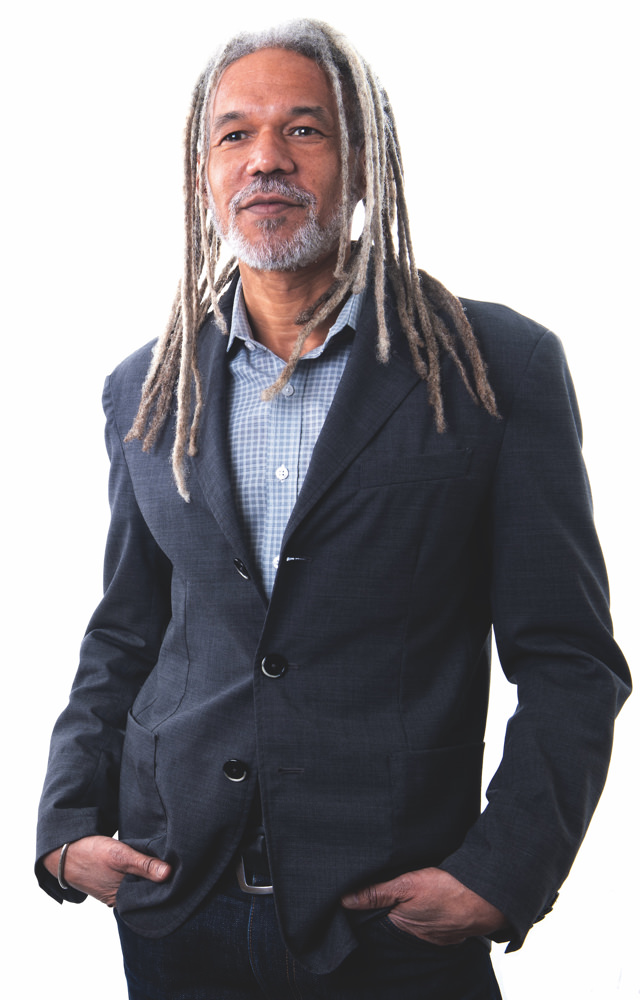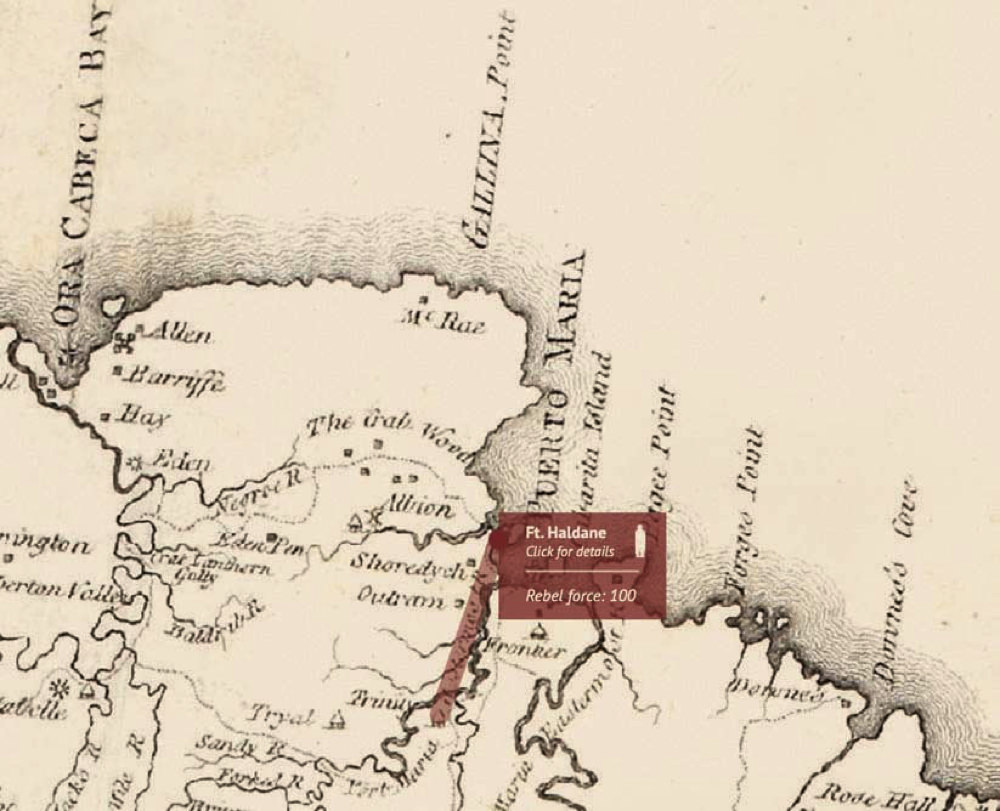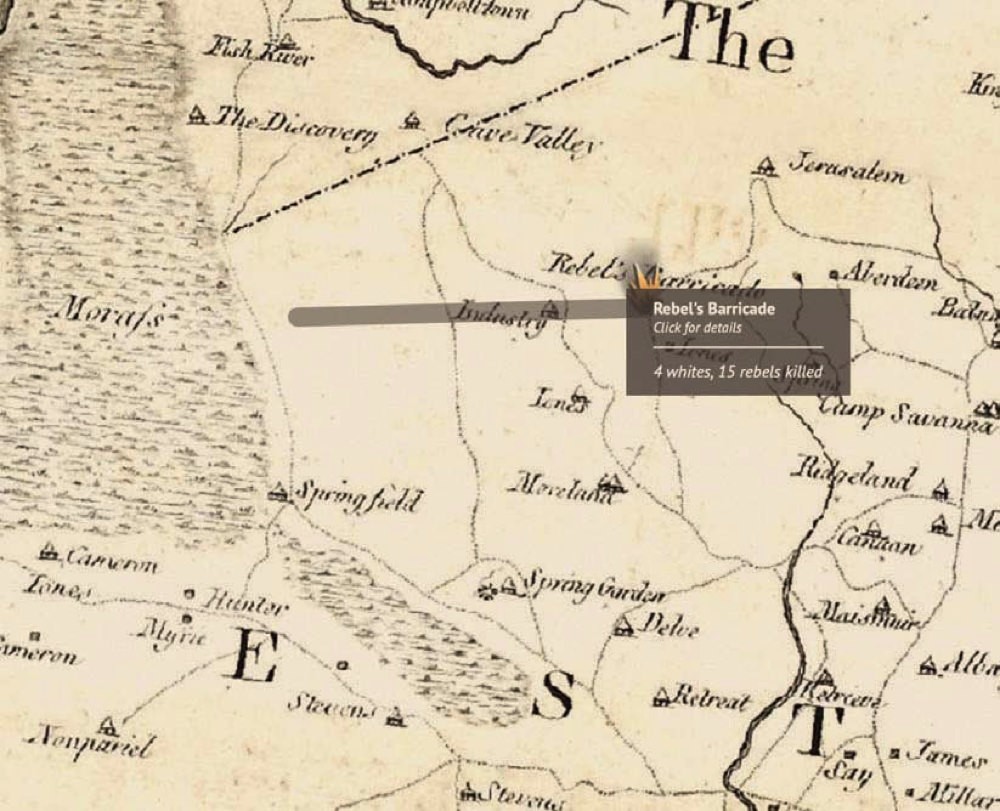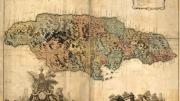Slavery, said historian Vince Brown last year, is a perpetual state of war. He was quoting the formerly enslaved eighteenth-century British abolitionist Olaudah Equiano, who bought his freedom in 1766. What did Equiano mean? Slavery resembles war in an immediate sense, Brown continued: it is a “forceful, collective assault” sustained by constant state terror. But it is also true in a literal sense. European colonial empires were created through vast networks of war and conquest, which created the displaced Africans sold into slavery and forced to power the economic and military engines of those same empires.

Vince Brown
Photograph by Stu Rosner
“How do you make a slave? You take dislocated, alienated people who are removed from their networks of care and connection, and they become vulnerable to predation,” says Brown, who is Warren professor of history and professor of African and African American studies, during a subsequent conversation. Maintaining that system requires war. “If we recast what we think of as slavery not just as work—which it mostly is—but as war, as a kind of military activity, you see all kinds of things….Wars to produce slaves. Wars to make territory for plantation slavery. The British, the Spanish, the French, and the Dutch and others fighting each other in the New World to take territory that they can exploit with those African slaves who are often themselves the products of dislocation caused by warfare in Africa.”
Brown, like a growing number of historians, sees slavery as an extension of the transatlantic wars that embroiled Europe, Africa, and the Americas during the era of European colonization. “Often in conversations about African-American history and African-American politics,” he says, “we don’t situate them as firmly as I think we ought to in the context of empire and militarization and warfare.” Brown’s writing on these subjects, most recently in his new book, Tacky’s Revolt: The Story of an Atlantic Slave War, has also taught him to view racism itself as a kind of “anti-black militarism”: “The racism that attended, supported, and outlived Atlantic slavery is a species of war as well.”
Tacky’s Revolt tells the story of the Jamaican slave revolt of the same name, the largest such rebellion in the eighteenth-century British empire, and a part of the larger Seven Years’ War among Europe’s colonial powers. The rebels—about 1,500 of them, possibly many more, marching across the island between April 1760 and October 1761—didn’t succeed in wresting their freedom from the British. But the revolt reverberated across the Americas and, along with other uprisings in the region, helped bring about the end of the slave trade. It also helped forge perceived links between blackness and violence that endure to this day.
Despite these connections, the revolt has not previously been understood as a part of the web of war that shaped the history of the Atlantic. “This has always been part of the history of slavery and the history of slave revolt, not part of a larger history of imperial warfare,” Brown says. Historians at the time “were willing to recognize the threat posed by black people, but were unwilling to concede that they were genuine political actors,” he writes in Tacky’s Revolt. That’s a mistake, he argues, because it ignores the military acumen that many of the insurgents had brought with them from Africa’s Gold Coast. They were revolting not from a position of inexperienced panic, but with the martial training and leadership they had gained on a continent that had been transformed by colonial slave wars. Apongo, one of the rebellion’s leaders, had been a West African military leader and, after his capture and sale, a sailor in the British Royal Navy and a driver on a Jamaican plantation. The insurgents were not merely victims of imperial warfare, but participants in it.
In fact, communities of Africans, known as maroons, managed to create free societies of their own on the margins of empire throughout the Americas. In Jamaica, huge numbers of enslaved people were imported during the seventeenth and eighteenth centuries, resulting in what Brown calls “a seemingly unrelenting series of slave rebellions.” Bands of runaways built villages and cultivated crops in the mountains, where it was difficult for the colonists to fight them. Some of them officially won their sovereignty after the First Maroon War in 1739, in exchange for helping to catch future runaways and providing military support to the British. News of these insurrections no doubt reached future rebels like Apongo.
“More and more historians are seeing that the African background of the slave system is really critical,” says Marcus Rediker, an historian at the University of Pittsburgh. Rediker’s The Amistad Rebellion (2012) showed that the key to that pivotal 1839 revolt, which resulted in a U.S. Supreme Court case, had been the rebels’ training as warriors in Sierra Leone. “Vince’s work,” he explains, “is taking this theme and showing how Tacky’s Revolt in Jamaica was premised on a whole set of experiences that people brought with them from West Africa.”
“Who gets to count as an historical agent? Who is seen as someone who helps make history?”
The tradition that he and Brown work in, Rediker adds, is sometimes called “history from below”: “This is the history of people who have been left out of a great many historical accounts….Who gets to count as an historical agent? Who is seen as someone who helps make history? By recovering these military traditions in West Africa and showing how they drove a slave revolt, Vince is in a very real way restoring agency to the enslaved people that he studies.”
Brown speaks, even off the cuff, in polished, fully formed paragraphs, as he connects his lifelong interest in warfare to his childhood in San Diego: “one of the largest military garrisons in the history of the world, and one of the most potent.” He saw war all around him: his father and uncles, like many black men of their generation, had served in the military. It was the 1980s, at a time when “the Cold War was heating up again, so talk of war and militarization suffused my childhood. And I often think that we separate off our national history, especially African-American national history, from this larger history of militarization and, frankly, empire that was very present to me growing up.
“I was born in 1967, at the height of the Vietnam War, and I think that I look back on those 50 or so years and it looks like permanent, endless warfare,” Brown continues. “And I grew up in a military town that was part of that, that was fundamental to the expansion of U.S. militarism across the world. How could my work not think about those themes?”
In college at the University of California, San Diego, he focused on the threat of nuclear war in the contemporary world, studying history, with an emphasis on arms control and diplomacy. “The way people talk about Extinction Rebellion now—climate change—was the way we thought about the potential of nuclear warfare in the 1980s,” he remembers. “The reanimation of the Cold War with Ronald Reagan’s election was something that really scared a lot of people….This was, for me, an urgent priority, to think about how it is that arms control could work.” During Reagan’s arms-control negotiations with Soviet leader Mikhail Gorbachev, Brown took part in a mock negotiation: “one of the best, most illuminating classes I had, where half the class were Soviets and half were Americans and we tried to negotiate an arms treaty....In some ways, I kind of had of training as an undergraduate in great-power strategy, diplomacy, histories of warfare.”
After the end of the Cold War, the threat of nuclear annihilation seemed less urgent. Still, Brown says, “I still think despite the fact that it’s not as present a topic as climate change is now, the potential for nuclear war between great powers, the problem of warfare and endless war, is, to me, like an existential problem....It’s just assumed, for the most part, that the United States is going to be engaged in warfare somewhere in the world forever.” Brown’s work is preoccupied with the many ways that war is never merely war: with how it metastasizes and gives shape to enduring horrors like slavery and racism. So, he asks, what does it mean for the United States to be in an endless war? “I think we need to start thinking about that a lot more seriously.”
Brown says he was always drawn as much to the arts as to history: growing up, he loved to draw, and he was “a big thespian” in high school. He minored in theater in college, and after graduating in 1990, thought he might try it out as a career, auditioning for stage and on-screen roles in San Diego and Los Angeles. That path didn’t work out, he remembers, in part because the opportunities available to black actors were so limited in the early 1990s: “To the extent that there were black roles on screen, they were mostly what they called ‘urban’ roles, which was kind of a euphemism for ‘street.’ And that just wasn’t me.” Pursuing history instead, he explains, allowed “more control over my own representation.”
Alongside his college work on nuclear-arms control, Brown had also studied African-American history. In an independent study with historian Steven Hahn, he read The Black Jacobins, a history of the Haitian revolution by Trinidadian historian C.L.R. James. “When I read that book I thought, ‘Ah, here is a kind of global history of slavery,’” he recalls. “That connected up my interest in geopolitical affairs with my interest in African-American history and emancipation.” He looked for graduate programs where faculty were doing this kind of Atlantic history, and ended up at Duke in 1993.
“Sugar was so profitable that it was more efficient to buy people through the slave trade, work them to death over the course of five to seven years, and buy new people.”
Brown’s Ph.D. work focused on how the brutal death rates in Jamaica formed its culture and politics. Colonizers and enslaved people alike were constantly dying of tropical diseases (and, for the enslaved, merciless working conditions). By the mid-eighteenth century, Jamaica had become Britain’s most profitable colony. “Sugar was so profitable,” says Brown, “that it was more efficient for sugar planters to buy people through the slave trade, work them to death over the course of five to seven years, and buy new people…than it was to allow them enough food and rest and necessities to live long lives.” British sugar planters coming to the Caribbean could become obscenely rich, but they did so knowing there was a good chance they would die first. While Brown was a student, he explains, historians already knew that “sugar-plantation societies were deadly societies....What we didn’t know was how people responded to that.”
Brown’s curiosity had also been shaped by his post-college environment. He’d spent time working in San Francisco before graduate school, during the initial age of AIDS. “Thinking about that epidemic disease and all the people who were dying during that period raised a question: what does it mean, culturally, to have so many people dying all at once?” he explains. “I did wonder what it meant to be…going to funerals every weekend as just a kind of daily part of your life.”
The idea for his dissertation came when Brown encountered a book on Brazilian sugar plantations by historian of Latin America Stuart Schwartz. Enslaved Africans put to work on one of these plantations in the 1750s would have seen almost half their cohort die in that decade. “And then [the book] said something to the effect of: ‘We can’t know what that meant.’ I took that as a provocation. I remember when I saw that passage, I thought, ‘Well, can we know what that meant?’”
The resulting research, which would become his first book, The Reaper’s Garden: Death and Power in the World of Atlantic Slavery (2008), argued that death wasn’t just a demographic fact. It transformed the cultural landscape of colonial Jamaica through what he calls “mortuary politics”: the complex ways that inheritance, property ownership, social networks, and spiritual practices were influenced by constant death. “Death in Jamaica destroyed individuals, while generating a society,” he writes. High mortality intensified the presence of the dead in the daily lives of the living: “Everywhere in Jamaica, one could hear the sounds of black funerals…funerary rites were an urgent priority and were perhaps [enslaved people’s] most extensive basis of social communion.” They involved “song, dance, and percussive rhythm, the means of communicating with spirits of all kinds.” Perhaps most interestingly, funerals also included what Brown calls “supernatural inquests into the cause of death”: “As pallbearers carried the body…[t]hey were directed one way or another by the spirit, which made a point of stopping at nearly every home in the slave quarters to demand reparations and atonement from debtors and enemies.”
These rituals were West African in origin, but Brown focuses on how they were used in their New World context to bind together new communities of the enslaved, who had come from different societies and knew different practices: “In the course of placating the dead person and sending the soul on its way, the supernatural inquest shaped values among the enslaved in a very significant way,” he writes. “Offenses that had been committed against the deceased had to be atoned before the spirit could leave the community….When friends and relatives acted as mediums for the deceased, they not only made criminal accusations on behalf of the dead, but also complained about petty conflicts—‘treachery, ingratitude, injustice, slander’—that threatened the peace of the slave quarters.”
On a more earthly level, slaveholders’ deaths could set in motion events that re-ordered the lives of their human property. Estate executors could sell the enslaved off to repay outstanding debts. As one observer put it: “[F]amilies are torn asunder, a complete dispersion takes place, and all the horrors of the African trade are again repeated.” Slaveholders might also leave inheritances to enslaved people or free them, as in the not-uncommon cases of children fathered with enslaved concubines. But wills were not always carried out as the deceased intended: executors could ignore or delay such stipulations for their own gain, or for what they deemed to be in the estate’s best interest, leading to fights over property and freedom.
“I just thought that the work he was doing was spellbinding,” recalls Walter Johnson, Winthrop professor of history and professor of African and African-American studies, about watching Brown presenting his research for The Reaper’s Garden. “He’s able to think about things that historians have a hard time thinking about in a way that doesn’t destroy the complexity or the vitality of it.”
There had already been decades of scholarly debate over the extent to which West African culture took root in the New World— and whether these cultural practices necessarily constituted a form of resistance to slavery—by the time Brown’s book appeared. “Some people would say there was more Africanity and some people would say there was less,” Johnson explains. “And Vince comes along and makes this very simple point. He says it doesn’t matter where a cultural form is from—it matters what it’s used for.” Slaveholders learned the cultural practices that the enslaved brought with them and then used those practices to terrorize or punish. Enslaved people frequently killed themselves, for example, perhaps believing that they would return to their ancestral lands and relatives after death. To deter such suicides, Brown wrote, slave owners mutilated the bodies of the dead and displayed the remains as terrifying public spectacles, such as hanging decapitated heads, or mounting them on poles. Their actions sought to show that not even death brought deliverance from the island; in addition, enslaved people who died by suicide were denied the funerary rites that enabled their transition to the afterlife.
Brown’s observation about how cultural practices were transformed, and by whom, in their new context was a revelation, Johnson says. “Vince gave this question a whole new life....In retrospect, it sounds like common sense. It’s like a good sentence: it seems completely natural, but you have to hew it out of a slab of solid rock.”
From the beginning of graduate school, Brown knew he wanted to combine historical work with his interests in the arts, and to connect with audiences beyond the academy. “There are lots of ways to tell stories,” he says. “There are lots of ways to make arguments. Why do they have to take their final form in a scholarly article or scholarly book manuscript?” So while writing his dissertation, he also began working on a film about twentieth-century anthropologist Melville Herskovits, best known for arguing that black American culture had some of its roots in West African traditions. Herskovits is hardly a household name today, but he helped to establish the fields of African and African-American studies, and to lay the foundation for current ideas about race and inheritance. His work connects with Brown’s interest in how scholars write about the African diaspora, and how this scholarship is refracted through society. Herskovits was also a subject particularly well suited to film, Brown realized, because much of his research had been based on hours of footage he’d taken on travels in Africa. Clips from Herskovits’s fieldwork frame the documentary, conveying the audiovisual evidence that animated his arguments.
Brown was still working on the project when he came to Harvard as a postdoctoral fellow in 2002 (he became an assistant professor a year later). The film finally aired as an hourlong PBS documentary, Herskovits at the Heart of Blackness, in 2010.
Combining interviews with historians, anthropologists, and people who had worked closely with Herskovits, it weaves a complex, provocative story of this white, Jewish-American anthropologist’s legacy. Herskovits’s fieldwork footage, combined with images of African-American life, invite viewers to think about the politics of visual representation. Did the ability to define African Americans, the film asks, give Herskovits power over them? How might his central claim, about continuity from Africa to African Americans, be used both to promote black political power (as it was by the Black Panthers), and to advance white supremacy? What does it mean that black writers like W.E.B. Du Bois, A.B. 1890, Ph.D. ’95, had already done work like this before Herskovits, but didn’t get credit because they were considered too political or dangerous? Without compromising the intellectual content of these debates, the film makes them compelling television for audiences that haven’t engaged with them before. “I always like to think of him as kind of the Elvis of African-American studies,” Brown says in the film. “You might think of someone like Elvis as someone who takes things that blacks have already been doing, and he gets the credit for them. On the other hand, you can say, ‘Here’s a guy who actually mainstreams rock and roll.’”
Brown’s instincts for representing his work visually have been central, more recently, to unraveling the story of Tacky’s Revolt. He and others working on “histories from below,” like the history of slavery, face a fundamental challenge: how to represent the ideas, plans, or desires of the enslaved when virtually all documents left behind present the views of their masters? Tacky’s Revolt was plotted in total secrecy, and the existing primary sources were written by whites who perceived only chaos on the ground. In 2011, Brown was awarded a Mellon Foundation fellowship intended for humanists who want to be trained in other fields and learn new research methods. He studied cartography and geography with scholars Tim Stallmann and Pavithra Vasudevan at the University of North Carolina, and became involved with counter-mapping, a practice that uses mapping to disrupt entrenched ideas about history, politics, and space. Brown eventually plotted the events of Tacky’s Revolt, a project that now lives online as an interactive, playable map that tells the story of the rebellion and the strategies that must have sustained it. Other work in the “digital humanities” often focuses on data visualization or quantitative analyses of texts, notes history graduate student Jonathon Booth, J.D. ’19, but Brown “is much more interested in being able to tell a story.”
“Viewed on the map, the insurrection appears to have been the product of genuine strategic intelligence, one that utilized Jamaica’s distinctive geography and aimed toward the creation of alternative enduring societies,” Brown wrote in an essay about the project. The first of the revolt’s three phases, on the northeastern side of the island, aimed at Port Maria and the surrounding commercial area—providing evidence for the intriguing idea that the rebels wanted to take control of trade and conduct commerce there. Later, on the opposite side of the island, enslaved people revolted on plantations at the base of a mountainous area and formed a fortified encampment there (perhaps intended as the beginnings of a permanent settlement like the villages of the maroons). The site was destroyed by the British in June 1760.


Moments from Brown’s map-based story of Tacky’s Revolt. Above: An attack targets Fort Haldane, at Port Maria, in April 1760. Below: Rebels clash with militia forces at their fortified encampment—labeled “Rebel’s Barricade” on the original colonial map—in May 1760.
Images courtesy of revolt.axismaps.com
What did these rebels want? “Freedom from enslavement would always be the primary goal,” Brown says. “But then you want to dig a little deeper than that: What does freedom mean to these people? It doesn’t mean the same kind of freedom along the lines of liberal principles that we think of. It can be negative freedom, certainly freedom from being subject to the will of another....But does it mean forming a maroon community, an independent community, in the mountains? That’s one version of black freedom in a place like Jamaica. Another version of black freedom might be creating a polity that has some outside access to the world, that’s not isolated, that’s not detached from society....Those are things that black people want as well.”
In 2010, while Brown was still a junior faculty member in Cambridge, he left for a tenured position at Duke. “Tenure was so uncertain at Harvard,” he remembers. Creating a documentary as a major scholarly project had defied the traditional path young scholars usually take to build their careers. But it wasn’t long before Harvard convinced him to come back. “Harvard is a much nicer place to be as someone with job security,” he says. “I wanted to contemplate what it would be like to be in this well-resourced institution with all these really great, smart people around to brainstorm with, without having that fear of constantly having to have my eye on the job market all the time, having to constantly think about how my work was going to play to the higher-ups.” Brown now harmonizes his interests in history and media as the founding director of Harvard’s History Design Studio (HDS), created in 2013: a workshop for researchers who want to explore new modes of researching and narrating history.
“Because of Vince, there is a space for me at Harvard,” says Robin McDowell, a Ph.D. student in African and African American studies and fellow at the studio who uses map overlays to conduct her research on slavery and environmental history in Louisiana. When she came to Harvard, she says, “I had this idea that I needed to be classically trained…and that I wasn’t going to be taken seriously because I had an art and design background. And with HDS and with Vince, it was very much like, ‘No, this is something cutting edge, this is something really cool, this is what we need. You’re going to bring insights to this field because of your way of seeing the world.’”
McDowell and other students interviewed consider Brown’s history design work as an extension of his generous advising, and his willingness to push modes of storytelling that may not be embraced by traditional historians. “Across the board, he is beloved as a mentor, as a historian, as a student advocate,” McDowell says. “Everything you have that’s different [in academia] is hard fought for and hard won. Vince, I’m sure, had to work to carve out a space for people like me....It’s because of him doing stuff that people weren’t expecting, that people weren’t comfortable with.”
After Tacky’s Revolt was suppressed, hundreds of the insurgents were transported to places like British Honduras, Cuba, and the North American colonies. “Wherever they found themselves, their knowledge of the war against enslavement arrived with them,” Brown writes in his new book. “[T]hey brought news of black struggle and white vulnerability, of the fractures in the slaveholding regime as well as its brutality. They represented the possibility of revolt as both an inspiration and a warning.” In the 1790s, the Haitian revolution overthrew colonialism and slavery, ending with that nation’s winning its independence from France. It’s possible that some of those insurgents came directly from Jamaica, Brown writes—and they were certainly roused by the eruptions of resistance taking place all around them.
“One of the most enduring myths in the corpus of racial fantasy is that whites are the underdogs, besieged by hyper-masculine and ultra-violent blacks.”
More immediately in Jamaica, in the wake of the revolt, life for people of color became harder. Free black and brown people had to prove that they had received their freedom legitimately—that they weren’t runaways in disguise. They had to receive “certificates of freedom” and wear “Badges of Freedom” on their shoulders signifying their status. “Unqualified freedom was coterminous with whiteness,” Brown writes. “All non-whites were politically suspect, and whites maintained a social and legal obligation to police, harass, and contain all black and brown people.” International sentiment against the slave trade was strengthened by the perception of Africans as dangerous: dependence on the slave trade came to be seen as a threat to security. As Brown puts it, “One of the most enduring myths in the corpus of racial fantasy is that white people are underdogs, besieged by hyper-masculine and ultra-violent blacks,” an idea that “would infect the political imagination of whites down to the present day.”
This year, Brown is on leave to begin work on his next project: a book on the history of the African diaspora. How do those descended from enslaved people across the world see themselves as part of a diaspora? How do they respond to racist ideas about their own alleged criminality—ideas that were forged in conditions of war and captivity? “The idea behind that book is going to be thinking about how it is that people have seen the need to cast their history as migrants, as people in a particular place, as being part of a global story,” Brown says. “So I will tell that global story, but hopefully through the eyes of people who have felt the need to tell that story to themselves. What kind of African diaspora is needed during the [early twentieth-century black-nationalist] Marcus Garvey movement, for example? What kind of African diaspora history do people tell themselves in the ’90s? What kind of African diaspora history might people tell themselves in the context of slavery? So it’s really about a history of storytelling about the African diaspora.”
If slavery is a kind of war, diaspora is its flip side, entangled with how Brown thinks about the history of enslavement, displacement, and resistance. “Warfare provides one initial set of conditions,” he says. Diaspora represents, if not freedom, a kind of survival—an answer to the social death inflicted by slavery.









